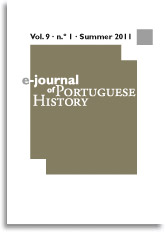


| CURRENT ISSUE | |||||||||||||
 |
Shaykh Zainuddin Makhdum, Tuhfat al-Mujāhidīn: A Historical Epic of the Sixteenth Century. Translated from the Arabic with notes by S. Muhammad Husayn Nainar. Kuala Lumpur / Calicut: Islamic Book Trust / Other Books, 2006. ISBN 983915480X/ 9789839154801.
Vasco Resende1
Completed in 1583, the Tuhfat al-Mujāhidīn fī ba’d a wāl al-Burtuġāliyyīn (“gift to the warriors of faith about some of the deeds of the Portuguese”) by Shaykh Zayn al-Dīn is a text of enormous propaganda value dedicated to the sultan Alī Ādil-Shāh of Bijāpūr (r. 1557-1580) and intended to denounce the war waged by the State of India (Estado da Índia) against the Muslim community of the Indian sub-continent, in particular the inhabitants of Malabar. Just as the author explains in his introductory text, the work is divided into four parts—the first dedicated to the theorization of the holy war against the Infidel (jihād), the second to the history of the expansion of the Muslim religion in Malabar, the third to describing the customs of the Hindu population, and the fourth (consisting of fourteen chapters) dedicated to telling the history of the Portuguese in Malabar, from their arrival in the late fifteenth century to the period after the loss of the fortress of Chalé (1571). Besides the work’s obvious interest—it is one of the few Asian sources testifying to the reaction of the Muslim populations to the Portuguese expansion into the south west of India—the Tuhfat al-Mujāhidīn is a text of great importance because it recounts the origins of the māppila community (Indian Muslims of Arab origin) in the region. The chronicle of Shaykh Zayn al-Dīn is not unknown to those who are interested in the history of the Portuguese expansion in southern India. In fact, in 1898, David Lopes published a Portuguese translation from the original Arabic text, accompanied by a long introductory text and extensive critical notes, entitled História dos Portugueses no Malabar. This edition, which rapidly became a reference tool for Portuguese-speaking historians, was republished more recently (1998) with modern-day spelling by Edições Antígona but without the introductory chapters devoted to the history of Malabar, Indian trade, the St. Thomas Christians, and the Jewish community of Cochin. The edition that is being reviewed here is the republication of the English translation of Shaykh Zayn al-Dīn’s text by S. Muhammad Husayn Nainar, which was published for the very first time in 1942 by the University of Madras. Now added to this original publication are copious notes written by C. Hamza, who was responsible for the translation of the same work into Malayalam (the language spoken in Kerala) in 1995. In fact, it is precisely this aspect that is of most interest in this new publication, insofar as it results from the amalgamation of the work of two different historians about the chronicle of Shaykh Zayn al-Dīn, which naturally serves to enrich this edition. The notes are valuable for readers who are interested in having more detailed information about the Islamic society of the sub-continent in the sixteenth century, particularly those referring specifically to Islamic theology and the commentary on the hadīths (statements attributed to the prophet Muhammad) in the Introduction and the first part of the work, a subject that is considerably less developed in the notes to the Portuguese version. The same can be said about the notes that accompany the sociological portrait of the Hindu population in the second part. This is not, in fact, the only advantage of Nainar’s edition. In his translation, David Lopes had decided to transcribe the Oriental place names from the Arabic version according to a system of Romanization adapted to the Portuguese language with a view to the text being published for a Portuguese-speaking audience, a criterion that the historian also followed in his other works dedicated to the study of the Arab world. However, for the modern reader, it seems much more practical and interesting to maintain a transliteration that comes close to the transcription systems prevailing in the main publications of Oriental studies, as is the case with this edition. However, despite its limitations, David Lopes’ edition remains a mandatory text for consultation by any student of the history of the Portuguese expansion in India, largely due to the contextualization that it provides of the events narrated by Zayn al-Dīn and the comparison that it makes with the material gathered from the Portuguese sources of that time. Instead of this, however, the information that serves as the basis for Nainar’s and Hamza’s notes about the events relating to the Portuguese was gathered from works written in English and belonging to the British colonial historiographic tradition in the nineteenth century, namely William Logan’s Malabar Manual (1887), which explains the strange form that is given to the names of some of the historical figures mentioned (for example, “Lorenzo Almeyda”). Consequently, the material about the evolution of the State of India is fairly poor, taking into consideration the great wealth of the Portuguese sources for the time period under study, and which David Lopes makes abundant use of in the notes to his translation. In conclusion, although the publication of Muhammad Husayn Nainar’s edition is a work of undeniable interest, historians of the Portuguese expansion will nonetheless have to continue to make a parallel use of the David Lopes edition for the chapters of Tuhfat al-Mujāhidīn relating to the evolution of the Portuguese presence in Malabar. In any case, for understanding the development of the history of the Muslim community in the region, consultation of the articles by Geneviève Bouchon compiled in the collection Inde découverte, Inde retrouvée (1999) is absolutely essential.
Notes 1New University of Lisbon. Center for Overseas History (CHAM), Portugal. E-mail: [email protected] Copyright
2011, ISSN 1645-6432
|
||||||||||||
| ...... | ....................................................................................................................................................................................................................................................................... | ||||||||||||
| COPYRIGHT@ 2008 E-JOURNAL OF PORTUGUESE HISTORY, ALL RIGHTS RESERVED webdesign TVM DESIGNERS | |||||||||||||